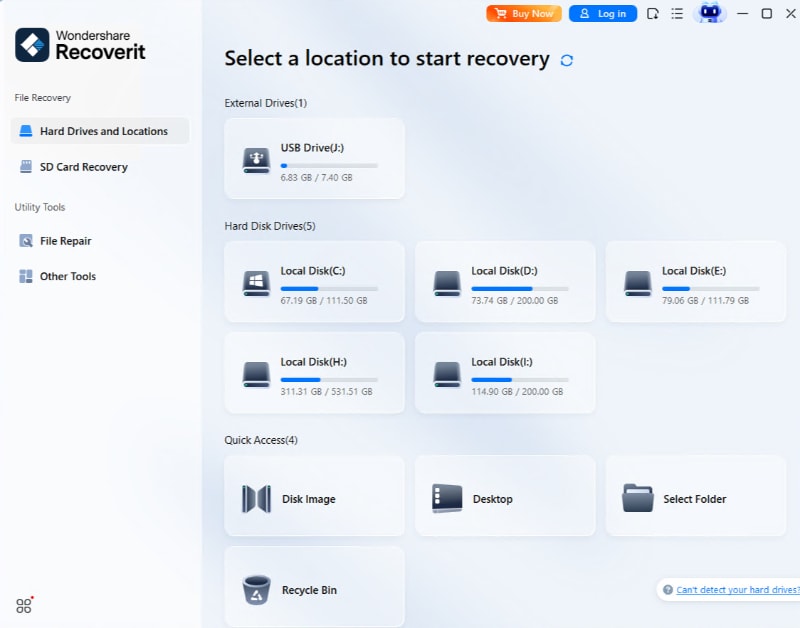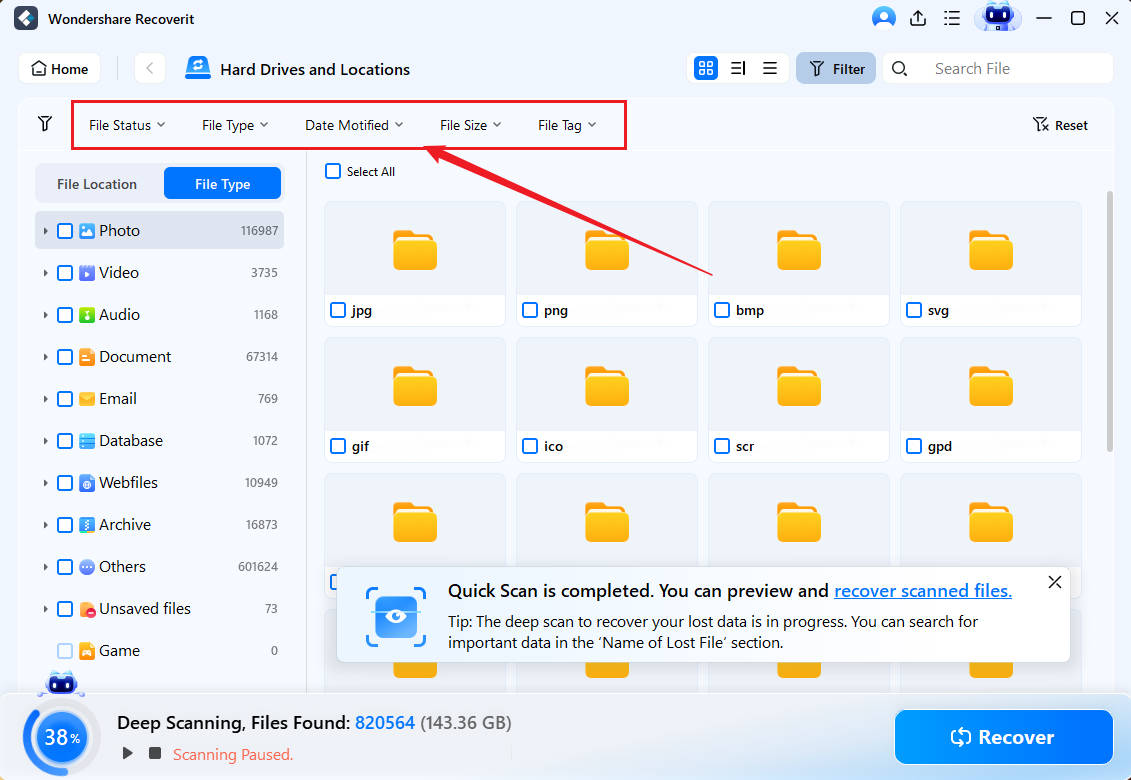Have you ever been working on something important on your Windows 10 or Windows 11 computer when suddenly you saw the Blue Screen of Death (BSOD)? If this has happened to you, don't worry, because we're here to help you fix this annoying problem.
In this detailed article, we'll look at what might be causing the Blue Screen of Death error, give you step-by-step instructions on how to fix blue screen Windows 10/11, show you how to get back any lost files, share tips to avoid this happening again and finish with a complete summary.
In this article
What Causes the Blue Death Screen Error
The Blue Screen of Death can be triggered by various underlying issues, including:
- Hardware conflicts: Incompatible or faulty hardware can trigger BSOD errors.
- Driver issues: Outdated, corrupted, or incompatible device drivers are a frequent culprit.
- Software conflicts: Newly installed programs or updates can sometimes clash with existing software.
- Overheating: When your computer's components get too hot, it can lead to system instability and blue screens.
- Failing hardware: A dying hard drive, faulty RAM, or other deteriorating components can result in blue screen errors.
- Power supply problems: An unstable or failing power supply unit can cause system crashes.
- BIOS issues: Outdated or incorrectly configured BIOS settings can lead to system instability.
- Windows updates: Sometimes, Windows updates themselves can introduce bugs that cause blue screens.
- Overclocking: Pushing your hardware beyond its stable limits can result in system crashes.
Understanding these causes is the first step in learning how to fix blue screen Windows 10 or Windows 11 issues.
How to Fix Blue Screen Windows 10/11
When faced with a blue screen error, it's essential to approach the problem systematically. We'll go through several methods to fix blue screen Windows 10 and Windows 11 issues, starting with the simplest solutions and progressing to more advanced techniques.
For each fix, we'll explain why it's effective and provide step-by-step instructions.
Fix 1: Shut Down the PC and Restart
Often, a blue screen error can be a one-time occurrence due to a temporary glitch in the system. A simple restart can clear the computer's memory and stop all processes, potentially resolving the issue.
Here’s how to fix blue screen Windows 11:
Step 1: If your PC is stuck on the blue screen, press and hold the power button for about 10 seconds until it shuts off. Wait for about 30 seconds.

Step 2: Press the power button to turn your PC back on. Allow Windows to start normally and see if the blue screen error reoccurs.
If the blue screen doesn't appear after restarting, it may have been a one-time error. However, if the problem persists, move on to the next fix.
Fix 2: Disconnect External Devices
External devices and their drivers can sometimes conflict with your system, causing blue screen errors. Disconnecting these devices can help isolate the problem and potentially resolve the issue.
Here’s how to fix blue screen Windows 11:
Step 1: Shut down your PC completely. Unplug all external devices except for the essential ones (keyboard and mouse).

Step 2: Disconnect printers, scanners, external hard drives, USB hubs, and any other peripherals. Restart your PC and observe if the blue screen error still occurs.
If the blue screen doesn't appear after disconnecting external devices, reconnect them one by one, restarting after each connection. This process can help you identify which device might be causing the problem.
Fix 3: Boot Windows PC in Safe Mode
If the blue screen doesn't occur in Safe Mode, it indicates that the issue is likely caused by a driver or software that doesn't load in this mode.
Here’s how to fix blue screen Windows 11:
Step 1: Restart your PC. If it doesn't boot normally, let it fail three times, and Windows will automatically enter the Advanced Startup Options menu.

Step 2: Select "Troubleshoot" > "Advanced options" > "Startup Settings". After the restart, press F4 to start in Safe Mode. Once in Safe Mode, check if the blue screen error occurs.
If your system runs stable in Safe Mode, you can use this opportunity to uninstall recently added software or update drivers, which we'll cover in the next fixes.
Fix 4: Uninstall Recently Installed/Conflicting Software
Sometimes, newly installed software can conflict with existing programs or system files, leading to blue screen errors. Removing these programs can often resolve the issue.
Steps to fix blue screen Windows 10 or Windows 11 by uninstalling the software:
Step 1: Boot into Safe Mode if possible (see Fix 3). Press Windows Key + I to open Settings. Go to "Apps" > "Installed Apps." Sort the list by "Install date" to see recently installed programs.

Step 2: Select any suspicious or recently installed programs. Tap the three-dot icon next to the app and click "Uninstall." Restart your PC and check if the blue screen error persists.
Pay special attention to any software you installed just before the blue screen errors started occurring.
Fix 5: Roll Back Device Drivers
Outdated, corrupted, or incompatible device drivers are a common cause of blue screen errors. Rolling back to a previous version of a driver can often resolve these issues.
Steps to fix blue screen Windows 10 or Windows 11 by rolling back drivers:
Step 1: Boot into Safe Mode if possible. Right-click on the Start button and select "Device Manager." Expand the categories and look for devices with a yellow exclamation mark. Right-click on the problematic device and select "Properties."

Step 2: Go to the "Driver" tab and click "Roll Back Driver" if available. If not available, click "Update Driver" and choose to search automatically for updated driver software. Restart your PC and check if the blue screen error is resolved.

If rolling back doesn't work, you may need to uninstall the driver completely and let Windows reinstall it upon restart.
Fix 6: Scan the PC for Viruses or Malware
Malware infections can corrupt system files and cause blue screen errors. Running a thorough antivirus scan can detect and remove these threats.
Steps to fix blue screen Windows 10 or Windows 11 by scanning for malware:
Step 1: Boot into Safe Mode with Networking. Open the Windows Security app. Run a full system scan.

Step 2: If malware is detected, follow the recommendations for removal. After removal, restart your PC and check if the blue screen error is resolved.
If you don't have an antivirus installed, you can use Windows Defender, which comes built-in with Windows 10 and 11.
Fix 7: Reset PC
If all else fails, resetting your PC to its factory settings can resolve persistent blue screen errors by eliminating software conflicts and corruption.
Steps to fix blue screen Windows 10 or Windows 11 by resetting your PC:
Step 1: If possible, back up your important files before proceeding. Go to Settings > "System" > "Recovery."

Step 2: Under "Reset this PC," click "Get started."

Step 3: Choose whether to keep your files or remove everything. Follow the on-screen instructions to complete the reset process.
Remember, this is a last resort as it will remove all installed programs and return Windows to its original state.
Lost Data Due to BSOD Error? Try Recoverit Today to Restore your Files
When facing persistent blue screen errors, there's always a risk of data loss. If you've lost important files due to a blue death screen, don't panic. Wondershare Recoverit is a powerful data recovery tool designed to help you retrieve lost files in various scenarios, including BSOD-related data loss.
Why use Recoverit for blue screen data recovery:
- Comprehensive Recovery: Recoverit can recover over 1000+ file types, including documents, photos, videos, and more.
- High Success Rate: With advanced algorithms, Recoverit offers a 99.5% high chance of recovering your lost data.
- User-Friendly Interface: Even if you're not tech-savvy, Recoverit's intuitive design makes data recovery straightforward.
- Preview Function: You can preview recoverable files before initiating the recovery process.
- Multiple Recovery Modes: Recoverit offers various recovery modes to address different data loss scenarios.
Key features of Recoverit:
- Deep Scan: Thoroughly scan your drive to find every recoverable file.
- Selective Recovery: Choose specific files to recover, saving time and storage space.
- Bootable Media Creation: Create a bootable USB drive to recover data from systems that won't start.
- RAW Recovery: Recover data from RAW or corrupted partitions.
- Safe and Secure: Recoverit doesn't overwrite your existing data during the recovery process.
Steps to use Recoverit for data recovery after a blue screen error:
Step 1: Install Wondershare Recoverit on a working computer. Connect the hard drive from your affected PC to this working computer. Launch Recoverit and select the connected drive as the target location. Click "Start".

Step 2: Wait for the scanning process.

Step 3: Preview the recoverable files after the scan.

Step 4: Select the files you want to recover and click "Recover." Choose a safe location (preferably on a different drive) to save the recovered files.
By using Recoverit, you can potentially salvage important data that might otherwise be lost due to blue screen errors in Windows 10 or Windows 11.
Tips to Avoid the Blue Death Screen Error on Windows 10/11
Here are some proactive measures you can take to minimize the risk of encountering the dreaded blue death screen:
- Keep Windows Updated: Regularly install Windows updates to ensure your system has the latest security patches and bug fixes.
- Update Drivers Carefully: Always download drivers from official sources and be cautious when updating. If a driver update causes issues, be prepared to roll back.
- Install Reliable Antivirus Software: Keep your system protected from malware that could cause system instability.
- Monitor System Temperature: Use software tools to keep an eye on your CPU and GPU temperatures. Ensure proper ventilation for your PC.
- Be Cautious with Third-Party Software: Research before installing new software and read user reviews to avoid potentially problematic programs.
- Perform Regular Maintenance: Use built-in Windows tools like Disk Cleanup and Disk Defragmenter to keep your system running smoothly.
- Back-Up Your Data Regularly: While not a direct prevention method, having recent backups can save you from data loss if a blue screen does occur.
- Keep Your PC Clean: Physically clean your PC's internals to prevent dust buildup, which can lead to overheating.
By following these tips, you can significantly reduce the likelihood of encountering blue screen errors and maintain a stable Windows 10 or Windows 11 system.
Conclusion
The Blue screen error in Windows 10 and Windows 11 can be a frustrating and sometimes scary experience for users. However, armed with the knowledge of what causes these errors and how to fix blue screen Windows 10 and Windows 11 issues, you can approach the problem with confidence.
We've covered a range of solutions, from simple restarts to more advanced techniques like driver rollbacks and system resets. If you encounter data loss due to a blue death screen, tools like Wondershare Recoverit can be invaluable in recovering your important files.
Keep your system updated, be cautious with software installations, and maintain your hardware to ensure a stable computing experience.
FAQ
-
How do I fix blue screen Windows 10 errors if my PC won't boot?
If your Windows 10 PC won't boot due to persistent blue screen errors, try booting into Safe Mode by interrupting the boot process three times. From there, you can perform troubleshooting steps like uninstalling recent updates or drivers. If that doesn't work, you may need to use a Windows recovery drive or perform a clean installation of Windows. -
Can overheating cause blue death screen errors in Windows 11?
Yes, overheating can definitely cause blue screen errors in Windows 11. When components like the CPU or GPU get too hot, they can malfunction, leading to system instability and blue screens. Ensure proper ventilation for your PC, clean out dust regularly, and consider upgrading your cooling system if overheating is a persistent issue. -
Is it possible to recover data after a blue screen crash in Windows 10/11?
In many cases, yes. If the blue screen error hasn't caused physical damage to your hard drive, you can often recover data using specialized software like Wondershare Recoverit. For best results, stop using the affected drive immediately after the crash and use a data recovery tool from a different, working computer.



 ChatGPT
ChatGPT
 Perplexity
Perplexity
 Google AI Mode
Google AI Mode
 Grok
Grok























